Home » Hospital & Durable Medical Equipment » Using 3D Diabetes Models with Younger Students » Using 3D Diabetes Models with Younger Students
Using 3D Diabetes Models with Younger Students
Juvenile diabetes and Type II diabetes numbers are on the rise in every developed country in the world. In the United States alone, approximately 23.6 million people, including young children, have the disease. About 90% of these individuals have Type II diabetes. Of this total number it is estimated that close to six million are unaware that they have diabetes.
These numbers are most problematic in African Americans, Hispanics and Asian Americans. This is not a socio-economic factor, but rather a genetic condition that causes the body to be able to survive times of low food intake much more successfully than Europeans. Unfortunately it also affects the insulin production and balancing of blood sugars if the right combination of factors are present. Typically factors that lead to diabetes in any group include a lack of routine physical activity, obesity, poor diet, rapid weight loss, and genetic predisposition. While genetics is not in the individual's control the rest of the factors certainly are.
Talking with younger students in elementary through high school about complex health issues such as diabetes can be challenging. Through the use of 3D diabetes models the kids can visualize and clearly understand what you are explaining. While talking about how diabetes affects the human eye, you can point at the model that includes the eye and even discuss what the impact of the condition is on vision.
Other parts of 3D diabetes models can provide the same type of structured information. The pancreas is highly detailed in cross section allowing you to explain in as much detail as appropriate the role of this organ in blood sugar regulation. From this starting point all other organs and body function can be connected as the possible results of a diagnosis of Type II diabetes. Complete 3D diabetes models should also include the foot, kidney, heart and the inside or cross section of an artery. Information on the background card of the model can be used to keep your lecture or presentation on track or to allow the older students to review the model on their own.
Really well designed 3D diabetes models will include the possible risks associated with Type II diabetes. While this may not be discussed with younger students, it is still a good teaching moment if questions are asked. The effects listed on the card behind 3d diabetes models discuss the possibility of stroke, hypertensive heart disease, insulin resistance, neuropathy and foot ulcerations.
Providing 3D diabetes models for students to observe during a discussion about this very serious health condition will help with learning by increasing the retention of information. The brightly colored and well designed graphics and 3D diabetes models aren't overwhelming to children and teens. Children see them as an accurate a true representation of the possible risks associated with unhealthy lifestyle choices. Starting out early with this type of education can help break the cycle of rising numbers of diabetics in today's world.
MSEC remains dedicated to providing the very best and the very latest in medical supplies and equipment. We never cease to be on the lookout for the latest innovation that will benefit both our many clients and the patients they dedicate their lives to caring for. If you have any difficulty finding your choices in our vast inventory, call our customer service at 1-877-706-4480 to speed up your order or to make a special request. We are always happy to help you.













 Unit: single
Unit: single



